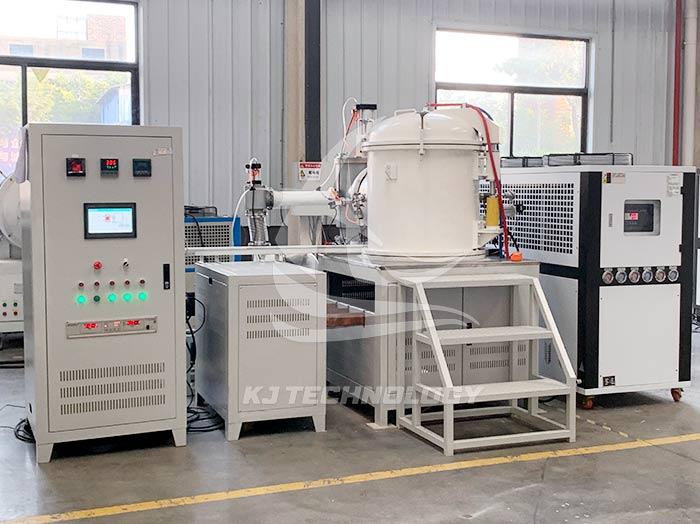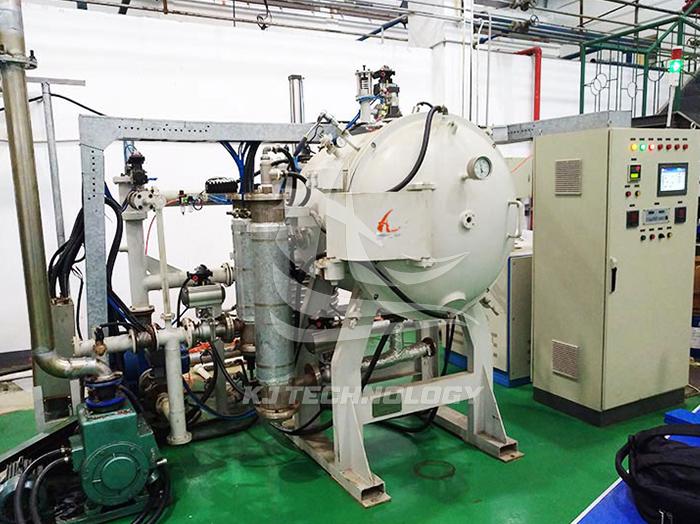Can high vacuum and high temperature muffle furnace sinter?
 09-16-2025 Author: KJ technology
09-16-2025 Author: KJ technology
The high vacuum and high temperature muffle furnace can sinter, and its sintering ability and advantages are reflected in the following aspects:
1. The core implementation conditions of sintering process
Vacuum environment inhibits oxidation
Under vacuum conditions (vacuum degree can reach 10 ⁻³ -10 ⁻⁴ Pa), the contact between the material and oxygen is greatly reduced, which can effectively prevent oxidation reactions of metals, ceramics, etc. during high-temperature sintering process. For example, when sintering titanium alloys, a vacuum environment can prevent titanium from reacting with oxygen to form brittle oxide layers, thereby obtaining high-strength and high toughness sintered bodies.
High temperature processing capability
The heating temperature range of high vacuum and high temperature muffle furnace is usually 500 ℃ -1800 ℃, and some models can reach over 2000 ℃, which can meet the sintering needs of different materials:
Metal powder sintering: The sintering temperature of iron-based and copper based powders is generally between 500 ℃ and 1000 ℃. Vacuum sintering can achieve densification, improve material density and mechanical properties.
Ceramic material sintering: The sintering temperature of alumina ceramics is around 1600 ℃, while high-performance ceramics such as silicon carbide and boron nitride require a high temperature of 1600 ℃ -1800 ℃ to achieve good sintering effect. Vacuum environment can avoid surface oxidation of ceramics, improve transparency and strength.
Composite material sintering: Metal ceramic composites, carbon fiber reinforced ceramics, etc. require interface bonding at high temperatures. Vacuum sintering can reduce interface reactions and improve material properties.
Uniform heating and precise temperature control
Uniform heating: By optimizing the furnace design (such as multi-layer heating element layout) and using efficient insulation materials (such as ceramic fibers and refractory bricks), the temperature uniformity inside the furnace can be ensured within ± 5 ℃, avoiding material performance differences caused by temperature gradients.
Accurate temperature control: Equipped with a PID intelligent temperature control system, it can achieve precise temperature control (± 1 ℃), meeting the strict requirements of different sintering processes for temperature curves. For example, the sintering of multi-layer ceramic capacitors (MLCC) requires precise control of heating rate and holding time to obtain products with high capacitance density and low loss.
2. Typical Application Cases of Sintering Process
Ceramic material sintering
Preparation of transparent ceramics: Sintering alumina ceramics in a vacuum environment at 1800 ℃ can eliminate pores and impurities, obtaining transparent ceramics with a transmittance of over 85%, suitable for high-pressure sodium lamp tubes, infrared windows, etc.
Electronic ceramic sintering: The sintering of ceramic capacitors requires vacuum sintering under nitrogen protection to avoid oxidation of the silver electrode, while controlling the sintering shrinkage rate (<0.1%) to ensure the electrical performance and reliability of the capacitor.
Metal material sintering
Powder metallurgy: Iron based and copper based powders can be densified through vacuum sintering, with a density of over 98% of the theoretical value and significantly improved mechanical properties.
Sintering of high-temperature alloys: The sintering of nickel based high-temperature alloys needs to be carried out in a vacuum environment of 1200 ℃ -1300 ℃ to avoid element volatilization and oxidation, and obtain high-strength and corrosion-resistant alloy materials.
Composite material sintering
Metal ceramic composite materials: By vacuum hot pressing sintering (temperature 1000 ℃ -1600 ℃, pressure 20-50MPa), the interface bonding between metal and ceramic can be achieved, obtaining composite materials with high hardness and toughness, suitable for cutting tools, molds, etc.
Carbon fiber reinforced ceramics: Sintering carbon fiber reinforced silicon carbide composite materials in a vacuum environment at 1600 ℃ can improve the fracture toughness and thermal shock resistance of the material, making it suitable for aerospace thermal protection systems.
3. Summary of the advantages of sintering process
Material performance optimization
Vacuum sintering can reduce the generation of impurity phases, improve material purity, and enhance mechanical properties (such as strength and hardness), electrical properties (such as capacitance density and dielectric loss), and optical properties (such as transmittance).
Enhanced process controllability
Accurate temperature control and uniform heating can achieve repeatability and stability of the sintering process, ensuring consistent product quality.
For example, the sintering process of MLCC requires strict control of the temperature curve, and vacuum sintering can ensure that the capacitance deviation of each batch of products is smaller.
Expansion of application areas
Vacuum sintering technology is applicable to various material systems such as ceramics, metals, and composite materials, and can meet the demand for high-performance materials in aerospace, electronics, energy, environmental protection, and other fields.
For example, vacuum sintered silicon carbide ceramics can be used for nuclear reactor fuel cladding due to their high strength, corrosion resistance, and radiation resistance.








